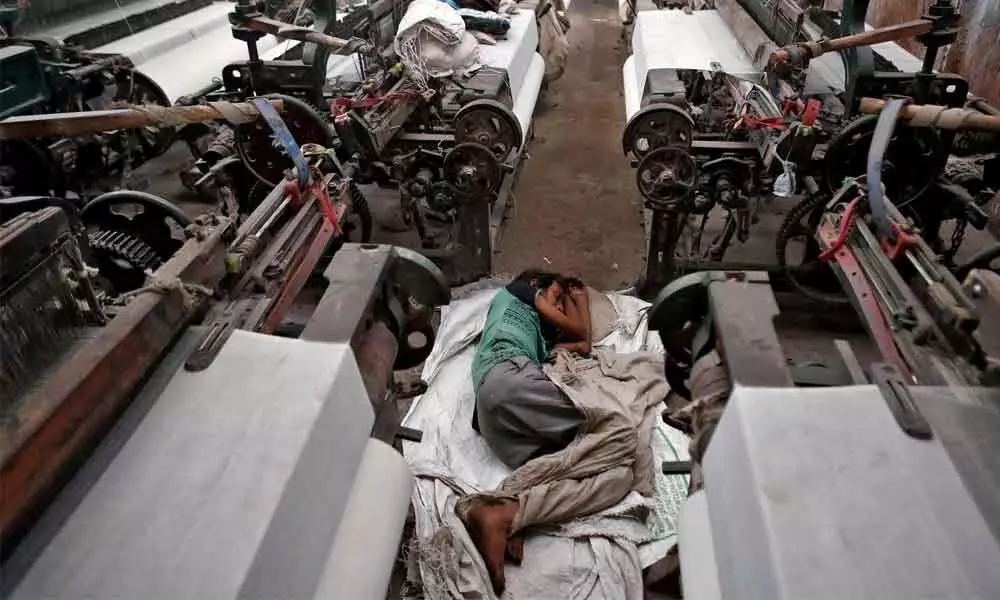Need to look beyond Labour Code

Need to look beyond Labour Code
We confront a difficult situation today. The numbers of workers employed will reduce if we increase the productivity of the workers due to the limited market. And, the numbers of workers employed will also reduce if we do not increase the productivity of the workers because industrialist will use machines.
We confront a difficult situation today. The numbers of workers employed will reduce if we increase the productivity of the workers due to the limited market. And, the numbers of workers employed will also reduce if we do not increase the productivity of the workers because industrialist will use machines. There will be job-displacement in both the situations. The only choice before us is whether we will reduce the size of our cloth by using a scissor or by tearing it. The second aspect of the problem is that of global competition. Our cost of production will be high, and we will be priced out of the global market if we do not increase the productivity of our labour. Therefore, we have to necessarily increase the productivity of our labour. The main objective of the code should have been to secure an increase in productivity so that we could stand in global competition irrespective of whether large numbers of jobs are created or not. However, there is little in the Labour Code in this direction
The government is to soon notify the rules for implementing the new Labour Code. Some provisions of the code are pro-labour. For example, the proceedings in a case of misconduct by a worker have to be completed in 90 days. Gratuity will now be payable to workers who have worked more than one year. Fixed-term employees have been given entitlement to all benefits that are payable to permanent employees. Other provisions are anti-labour. Closure or retrenchment for establishments employing less than 300 employees can now be made without obtaining permission from the government. Previously such permission was required for establishments employing more than 100 employees. The code is a mixed bag.
The stated objective of the code was to jumpstart manufacturing and employment generation. The numbers of youth entering the labour market is increasing by the day. The Medium, Small and Micro Enterprises (MSME) that were creating most employment have been badly hit by demonetisation, GST and the lockdown. A politician of Muzaffarnagar told me that 20 persons are selling vegetables today where only five were selling previously. The income of a vegetable vendor today is Rs 500 per day while previously it was Rs 2,000. This has declined because a number of workers have become unemployed and taken to such activities. The industries also have less interest in providing employment to workers. I know of a sugar mill that used to crush 2,000 tons of sugar cane everyday 40 years ago. The same mill is crushing 8,000 tons of sugar cane today but, the number of workers has come down to mere 500. One worker is doing the work that was done by 16 workers previously. Reason is that the cost of undertaking a particular operation by labour is more than undertaking the same operation by machines.
Industrialists will be encouraged to use more labour only if it is cheaper. Let us say a worker used to weave 10 metres of cloth in a day previously. It will become profitable for an industrialist to continue to employ him if he starts weaving 20 metres of cloth in a day. Otherwise, he may prefer to use an automatic loom and with less numbers of workers.
The model adopted by China was different. China improved the productivity of labour and simultaneously expanded the market. The worker started to weave 20 meters cloth now against 10 meters previously. At the same time, the market expanded from 10 meters to 40 meters. Thus, the industrialist who was using one worker to produce 10 metres of cloth previously began to use two workers to produce 40 metres of cloth. In this way, employment grew along with increase in labour productivity because the market was expanding rapidly. Our situation is fundamentally different because our growth rate today is not only lower than China's growth rate in the last 40 years, but it has also been declining in the last six years even if we exclude the last year 2020-21 that has been unusual due to the Covid-19 pandemic. Thus, increase in productivity today will lead to reduction of employment. Our dismal situation is brought to the fore in a paper published in "Developing Economies" that shows that the productivity of an Indian worker was 47 percent more than the Chinese worker in 1978. The situation changed dramatically in the next 25 years. The productivity of an Indian worker was 42 percent less than the Chinese worker in 2004.
We confront a difficult situation today. The numbers of workers employed will reduce if we increase the productivity of the workers due to the limited market. And, the numbers of workers employed will also reduce if we do not increase the productivity of the workers because industrialist will use machines. There will be job-displacement in both the situations. The only choice before us is whether we will reduce the size of our cloth by using a scissor or by tearing it.
The second aspect of the problem is that of global competition. Our cost of production will be high, and we will be priced out of the global market if we do not increase the productivity of our labour. Therefore, we have to necessarily increase the productivity of our labour. The main objective of the code should have been to secure an increase in productivity so that we could stand in global competition irrespective of whether large numbers of jobs are created or not. However, there is little in the labour code in this direction.
The main obstruction to increase in labour productivity is that the industrialist cannot dismiss an inefficient worker without giving any reason. He has to follow the principles of "natural justice" before he can dismiss a worker. The legal process is so tortuous and uncertain that an industrialist prefers to use machines rather than try to employ large numbers of workers and take the risk of going to labour courts.
We necessarily need to increase the productivity of our worker to stand in the global market. The Labour Code fails here. The facility of closure or retrenchment without previous permission given to establishments employing 100 to 300 workers is like capital punishment. It makes it easy to "kill" an establishment. It does not enable the industrialist to extract more work from the employed workers. Thus, the code will not beget an improvement of productivity of workers and we are likely to continue to slip in the global market. Further, even if provisions like dismissal without reason were introduced, that would not lead to the generation of much employment because fewer workers will be required to produce the same amount of goods. That will only help us stem the reduction in the current levels of employment but not get an increase in the same.
We need to look beyond the Labour Code for generation of employment. One possibility is to impose high rates of tax on machines that lead to the displacement of large numbers of workers such as JCBs, harvesters and the like. Second possibility is to provide in government contracts such as in the making of highways that specified works will be undertaken by labour rather than machines. Third possibility is to subject goods produced from labour intensive methods to lower rates of GST or Income Tax. The main point is that increase productivity will lead to reduction in employment. Therefore, we need to implement other economic policies to generate employment.
(The author is formerly Professor of Economics at IIM, Bengaluru)















